Looking to practice yoga with your friends or in a group? We list below nine easy and intermediate three person yoga poses for beginners.
Yoga is an ancient practice that dates back to the 5th century B.C. Several studies have shown how effective yoga can be in healing physical as well as mental ailments.
In the beginning, the only type of yoga was Hatha, which was performed alone. However, in the last few decades, several new forms of this ancient practice have emerged.
One of these is acro yoga, a type of partner yoga where traditional one-person yogic poses are modified so that two people or more can do them together. 3 person yoga is also a part of acro yoga.
In this article, we will cover a few 3 person yoga poses and share some tips on how to not get injured while doing them.
We have categorized the poses into beginner and intermediate levels so that you can identify the asanas most suited to you.
Easy Yoga Poses for Three People
Yoga poses with three people aren’t as complicated as they sound. Just like normal yoga, they involve the same physical movements and deep breathing, but you simply do them in coordination with your partners.
The key, of course, is synchronicity, balance, and being comfortable with each other. Here are some easy yoga poses for three people that can be a good starting point.
1. Lord of the Dance (Natarajasana)
Lord of the dance is one of those yoga poses for three people that demands perfect balance and coordination among the partners. Before trying this out, make sure that you and your partners are extremely comfortable and in sync with each other.
All three partners must start from the downward dog position, facing each other. Now, each person should take their right leg in the air and bend their knee. Make sure your right toe is pointed toward the ceiling and the left foot is well-grounded on the yoga mat.
Next, breathe in, take your right hand back and try to hold the right thumb of your right foot. If you cannot reach the thumb, try to hold the thigh, ankle, or whichever part of your leg you can comfortably reach. Take five breaths as you try to ground yourself in the pose before coming back to the starting position.
Next, do the same pose again with the left leg.
A nice variation is to hold each other’s (non-engaged) hand while doing the pose. It also helps to improve balance for each of you.
Another interesting variation to this pose is for the person in the middle to try a handstand with the two mates holding their legs to support them. This is, however, recommended for more advanced yogis.

Photograph: Shutterstock stock photos
2. Trio Warrior III
Warrior III is one pose that can be included in all types of yoga, including Ashtanga, Hatha, and Acro – and it can be done with three people or more.
First, ensure that all three of you are standing on a solid surface or ground. Keep your feet grounded as you prepare for this pose.
Start by facing each other in a triangle formation. Now, lean forward (like a lunge) while keeping the front leg firmly on the ground and raising the back heel off the mat.
Next, lean your chest and hips forward until they are parallel to the ground.
Keep moving forward until your back leg looks like a straight line and also parallel to the floor.
Now, lift your hands above the ground and bring them closer to your heart – make a prayer pose.
Once you feel comfortable, bring your hands forward. Stay in the position for at least five deep breaths before coming back to the original position.
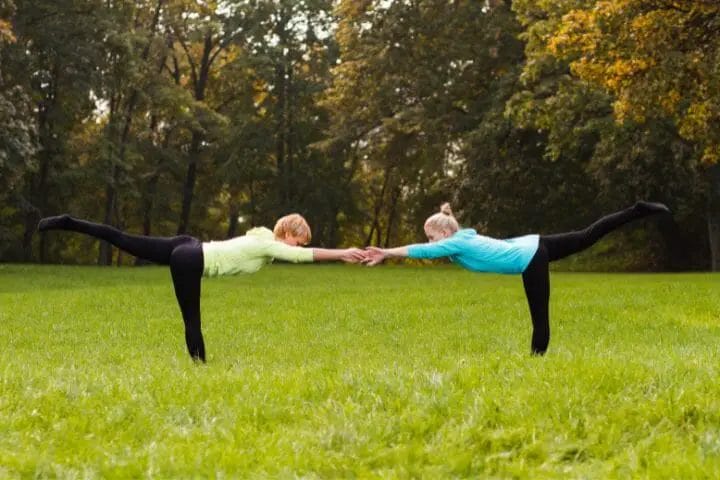
Photograph: Canva Stock Photos
3. Triple Forward Fold
To practice this pose, stand on your mat with your backs facing each other. Now, inhale and raise your hands above your shoulders with your fingers pointing towards the ceiling. You must feel the stretch in your spine.
With a deep exhalation, fold your body forward from the hips and try to touch your nose to your knees. You can bend your knees to meet the nose but make sure that your back is elongated.
Hold your toes or grab the ankles of your partners and stay in the position for a while before coming up with inhalation.
4. Lotus Circle
This is an easy and calming yoga pose to practice with your close friends. All you need to do is find a quiet place and get comfortable in a seated position, facing each other on your yoga mat (making a hexagonal shape with your feet). While sitting, you could either sit cross-legged or place your right foot on the left thigh.
Now, inhale deeply and lift your hands above your head and make sure that you are in sync with each other. As you exhale, bring your hands on your knees in the mudra position.
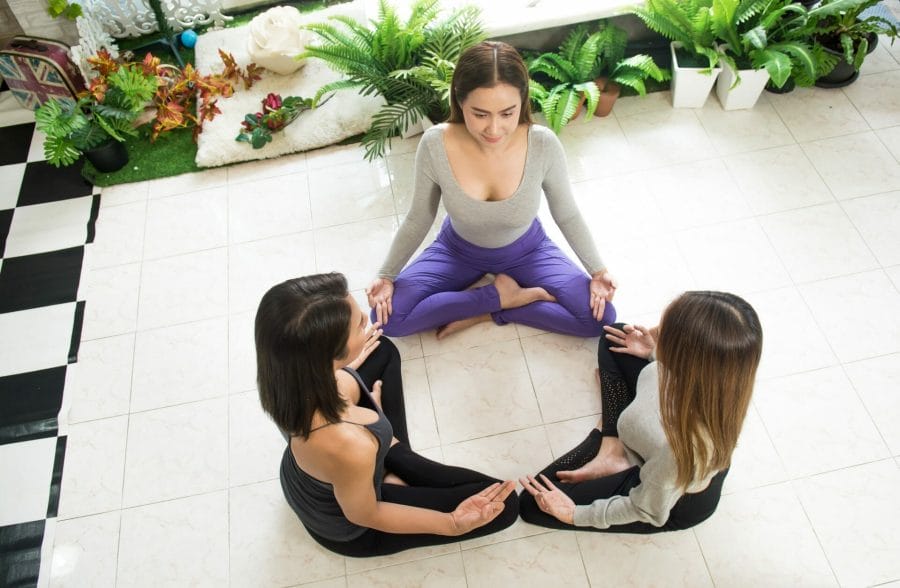
Photograph: Shutterstock Stock Photos
A variation of this is to sit in the back-to-back lotus circle. In this pose, the three partners sit in a way that their bodies are back to back and their knees touch each other. Put your right hand on the legs of the partner sitting on your right and your left hand on the legs of the friend seated on your left.
Your partners will do the same, and this will be your final position. Now, close your eyes and breathe deeply in this position. Again, make sure to sync your breath and become completely present at the moment.
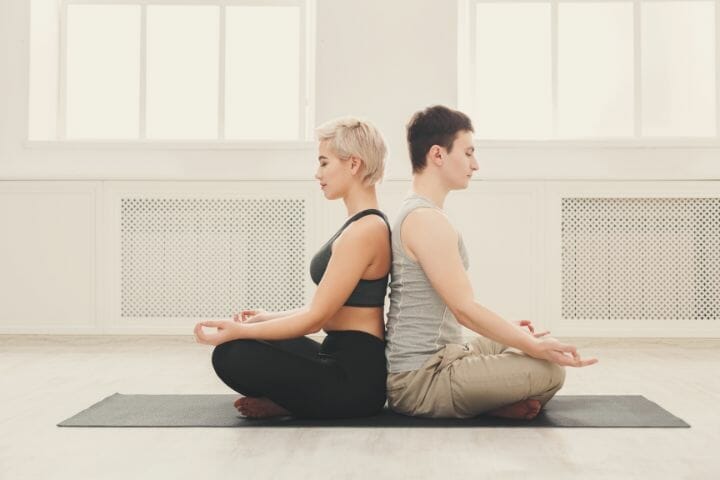
Photograph: Canva Stock Photos
Intermediate and Hard-Level Three-Person Yoga Poses
5. Triple Downward Dog (Adho Mukha Svanasana)
The downward dog is one of the easiest poses for beginners. However, doing it in a trio is a bit more difficult. Below, we talk about two variations of this pose, one for an intermediate practitioner and one for slightly more advanced yogis.
L-Shaped Triple Downward Dog
So, for this yoga pose, the first person will straight away get into the downward dog position. The second person will stand in front of the first person and go into the forward fold first and then press their hands on the mat.
Next, they will slowly raise their feet and bring them on the back of the first person in a way that looks like a half L.
Finally, the third person will follow the second person, but they will make a full L shape in the final position. It means that the back and the arms of the third person will be in a straight line like it is during a handstand.
Once all the partners are comfortable in the final position, they can slowly press each other’s back with their feet to deepen the stretch.
Pyramid-Shaped Triple Downward Dog
For the 3-person pyramid version, start with two people facing each other. Both should get down into the pose, facing each other so that it looks like you have made an “M” shape.
Next, the third person should position themselves in the middle of the heads of the first two. They should then use their hands to find support on the back of one partner and lift both legs one-by-one to rest on the back of the other yogi.
The end result would look like a small triangular pyramid. Maintain this pose for five deep breaths before coming down on the ground.
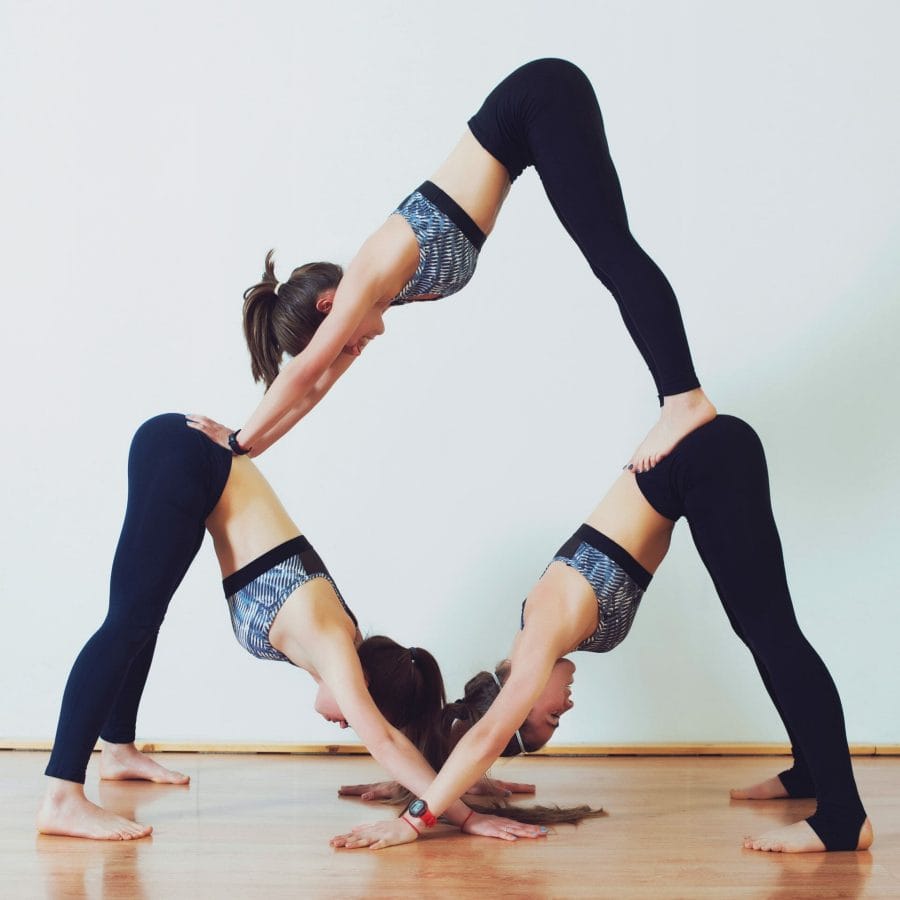
Photograph: Shutterstock Stock Photos
6. Three-Person Plank
The 3-person plank or “Plank-on-Plank-on-Plank” is the perfect pose for partners. You can prepare for this pose by lying on your mat with your back facing up (in the supine position).
Keep your feet together as you inhale and lift your legs and hands from the mat. Make sure that your legs and hands are at least shoulder-width apart and that your body is straight.
Keep your core muscles engaged as the next person would perform the same pose after climbing above you. The third person would follow them and hold the pose on the second person’s body.
Since the person closest to the mat will be carrying the body weight of the two people above, the two above should try and balance their weight between the arms and legs so that it is evenly distributed. Moreover, it might be best for the strongest person in the group to go at the bottom.
This pose helps tone the arms and also improves balance.
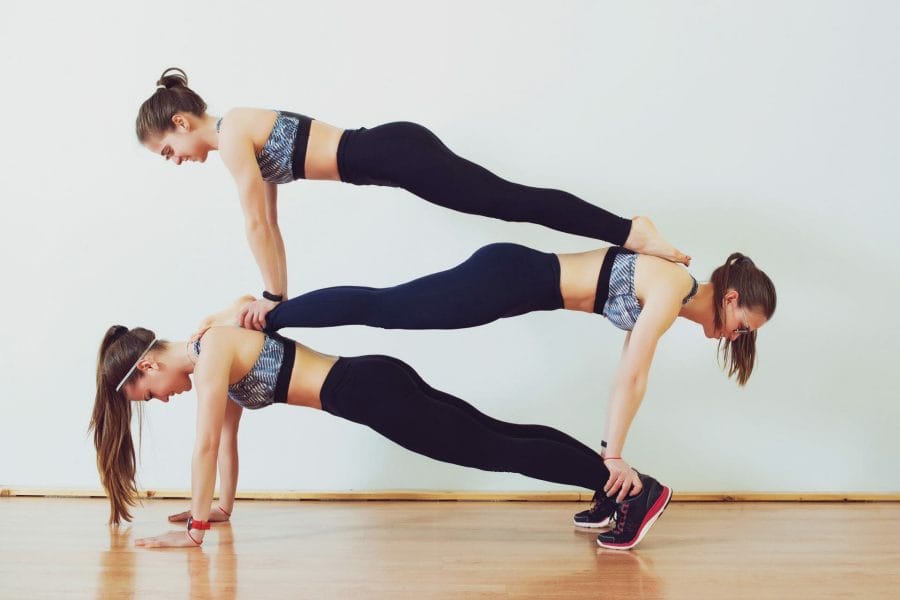
Photograph: Shutterstock Stock Photos
7. Leaning Double Side Bend
This is not one of the traditional yoga poses, but it is important in acro yoga. The pose starts with all partners standing side-by-side, forming a line.
Next, the middle partner spreads their legs up to a foot or more, and the other two practitioners hold the wrist of the central partner tightly.
The partners on either side inhale and start leaning towards the opposite side of the middle partner.
The role of the non-leaning partner is to stabilize the other two and ensure that there is no risk of injury as the other two keep leaning as far as they can.
The three of them can stay in the position for 3 to 5 breaths before the middle partner starts pulling the other two towards themselves.
8. Flying Handstand
The flying handstand is one of the most challenging positions in acro yoga. But when done under the guidance of a good teacher, it increases the practitioner’s confidence like no other can.
In a group of three, begin with two practitioners sitting in ‘sukh asana’ or easy pose (seated position) while facing each other.
The third practitioner should turn upside-down in the same way they practice regular handstands. However, they will ground their palms on the arms of the other practitioners and not the mat.
It is a challenging pose, and hence it is best that only those who have ample experience practicing handstands should do it. Avoid this pose if you are not confident about balancing yourself in a handstand.
9. Two-Person Whale with Spotter
One of the fascinating three-person yoga poses, the whale pose, requires a spotter (a third safety person who makes sure no one falls). All three can do the poses by taking turns.
The pose begins with the first partner getting into a table-top position. Make sure that the hands and knees are shoulder-width apart.
Now, the first yogi will lift their legs to 90 degrees with the bottom of the feet facing the ceiling or the sky.
Next, the spotter helps the second partner balance their body on the feet of the first partner. The second partner will stretch their spine as they try to maintain their balance. The spotter is crucial in ensuring that the second partner doesn’t fall.
This pose helps to stretch the upper thoracic spine of the practitioner.
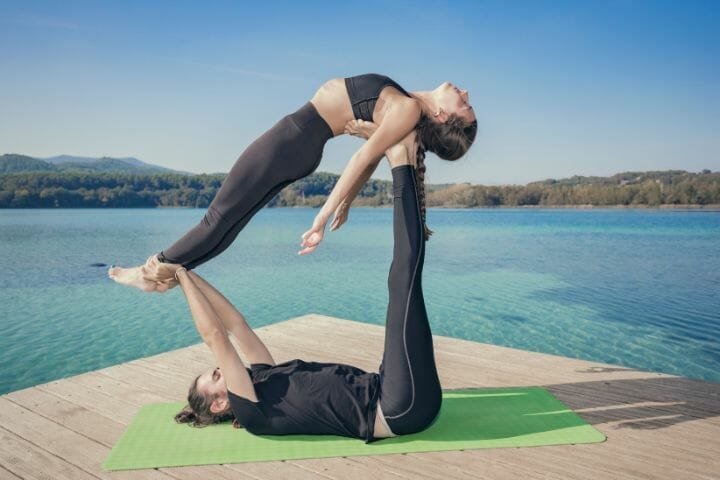
Photograph: Canva Stock Photos
Why Should You Do Yoga Poses In Threes?
Each person may have their reasons for practicing three-people yoga poses.
Some people try it because they know they will learn more about practicing yoga from their partners. Others might enjoy the challenge of practicing difficult poses with other practitioners.
For beginners, many poses seem impossible to practice without someone’s help, and this is another reason why yoga instructors form groups of two or three to do them.
Practicing yoga alone is fun, but it can get boring after a while. To break the monotony, trying new poses in the company of friends is a nice idea.
Most importantly, doing yoga together connects you and your partners in mind, body, and spirit like nothing else can.

Photograph: Canva Stock Photos
Mistakes To Avoid While Doing Yoga Poses With Three People
It is important to keep a few things in mind while practicing yoga poses with three people. We have shared them all in the below pointers.
- Take your time with the poses. Don’t rush into the poses just because you know how to do them as a single practitioner. Moreover, do not try to hurry your partners either.
- Refrain from forcing a pose if it seems difficult or painful on yourself or your partners. Remember, yoga is supposed to be therapeutic.
- Falls will happen, especially if you are practicing difficult poses. Try to keep yourself safe by using the right equipment – yoga mats, yoga blocks, and so on and practicing in the presence of a yoga teacher or an experienced spotter.
- If you are in a mixed group, be mindful of touching your partners inappropriately.
Frequently Asked Questions
What are the 4 pose families in yoga?
The four pose families in yoga include
- Mountain pose
- Warrior I
- Warrior II and
- Temple pose
The grouping of poses under these families is based on the position of the feet (and, if you are upside down, the hands) while doing the asana.
How many types of poses are there in yoga?
As per ancient texts, there are 84 yoga poses in total. The following are the main types of poses among these:
- Standing poses
- Sitting postures
- Back-bending
- Forward folds
- Supine positions
- Inversions
- Side-bending
- Twisting
- Balancing
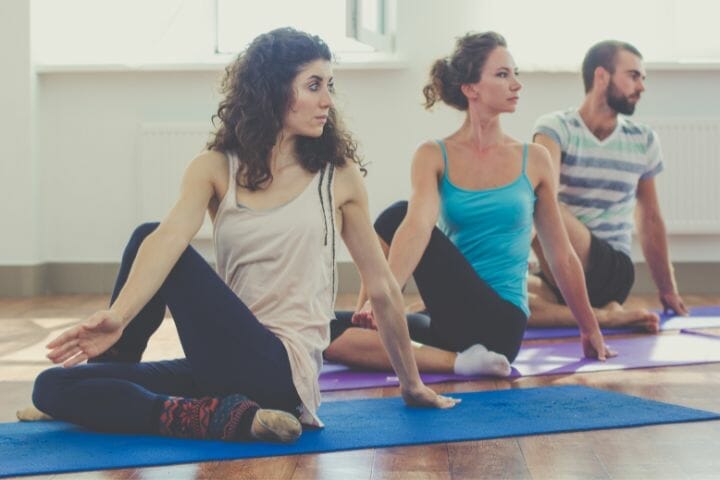
Photograph: Canva Stock Photos
Which is the hardest form of yoga for beginners?
Vinyasa flow and acro yoga are considered the hardest for beginners and require the presence of an experienced instructor.
However, it is the person’s strength and willingness to learn that decides whether the type of yoga they practice is difficult for them.
What things should I keep in mind while doing three people yoga?
While doing three people yoga, make sure that you are dressed comfortably in proper yoga clothing, whether you are wearing yoga shorts or yoga pants. This is particularly important, so that your clothes do not entangle with your partners.
Also, make sure that your hair are tied well, so that they don’t obstruct your vision. It’s also important to have a good yoga mat to help you prevent injuries.
Wrap Up
Though we have mentioned only nine, there are several yoga postures that you can practice in a group of three.
The best part about practicing three-people yoga poses is that you learn from each other and get to bond while also tuning your bodies and your minds.
Keep practicing, and make sure to always be safe while on the mat!